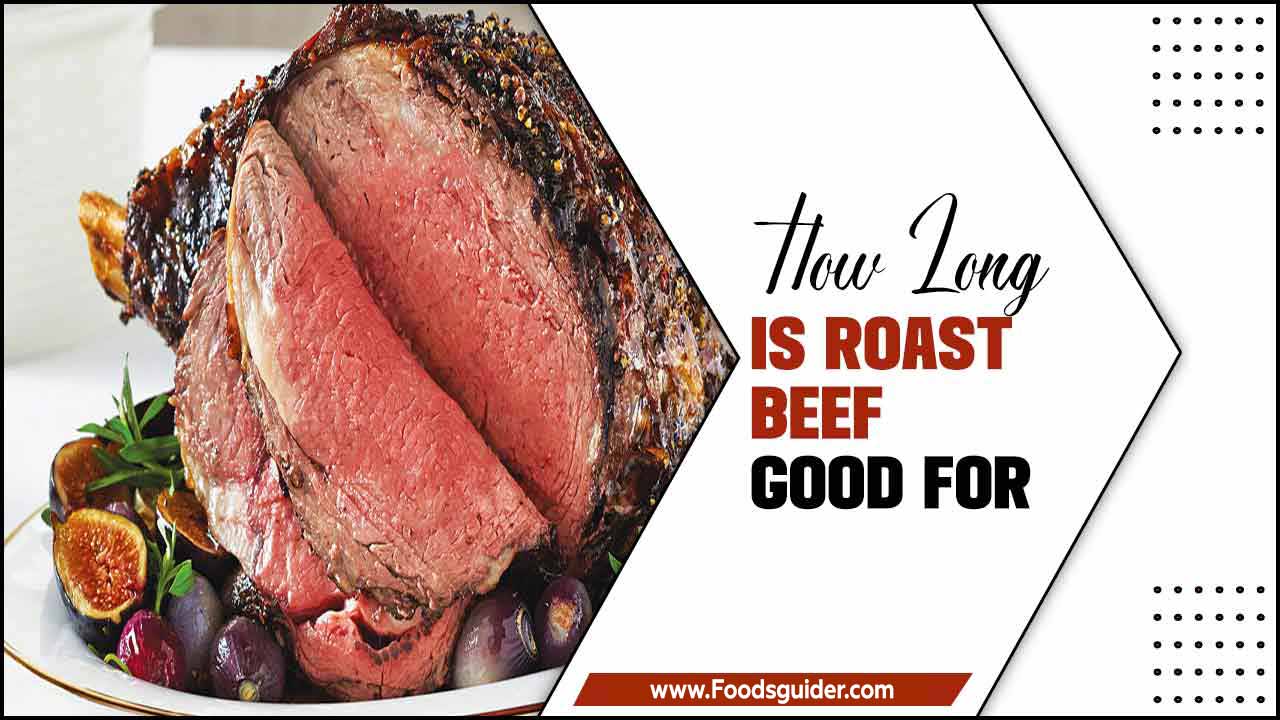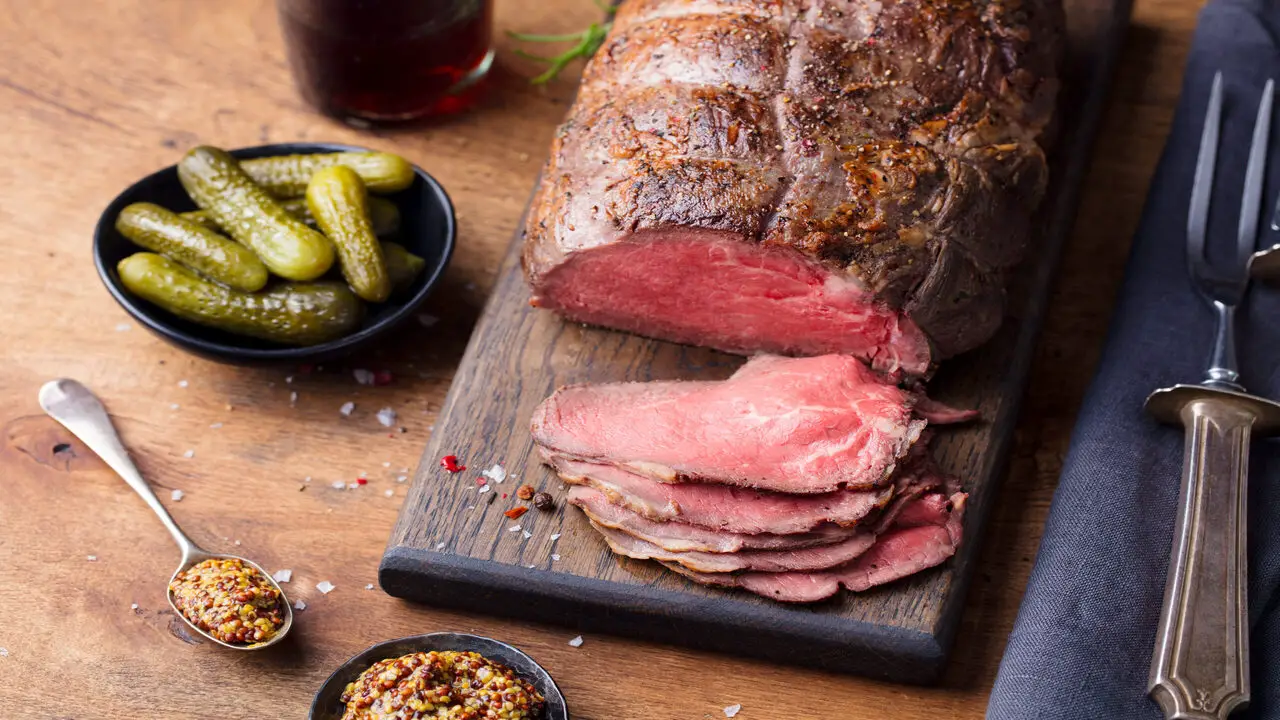It is important to know the shelf life of meat to avoid food poisoning and ensure you serve your family and guests safe and delicious food.
Are you wondering how long is roast beef good for? Several factors, such as the cut of beef, how it was stored, and whether it was cooked, determine the answer to this question. Generally, you can store raw beef in the refrigerator for up to five days, while cooked beef can last for three to four days.
However, if you want to extend the shelf life of your roast beef, you can freeze it. Frozen beef can last for up to six months without losing its quality. Following proper storage and handling techniques is crucial to keep your roast beef fresh and safe to eat. We will discuss in detail how long roast beef is good for and provide tips on maximizing its shelf life.

Factors That Affect The Shelf Life Of Roast Beef
Several factors can affect the shelf life of roast beef. The first factor is the initial quality of the beef. High-quality fresh and properly stored beef will generally have a longer shelf life than lower-quality beef. Temperature is another important factor.
Roast beef store below 40°F to prevent the growth of harmful bacteria. Packaging also plays a role in shelf life. Vacuum-sealed packaging can prolong the shelf life of roast beef compared to non-vacuum-sealed packaging. Finally, the age of the beef at the time of roasting can also affect its shelf life. Younger beef tends to have a longer shelf life than older beef.
How Long Is Roast Beef Good For – Ensuring Roast Beef Remains Edible

When stored correctly, Roast beef remains safe for about 3 to 4 days. You should promptly refrigerate it at a temperature of 40°F (4°C) or below after cooking. Proper storage involves tightly wrapping the meat in plastic wrap or aluminum foil or placing it in airtight containers to prevent exposure to air.
It can maintain its quality for up to 12 months when freezing roast beef. It’s crucial to reheat the beef to an internal temperature of 165°F (74°C) before consuming. Always discard any roast beef that shows signs of spoilage, such as an off odor, slimy texture, or mold growth. Here is explained how long is roast beef good for.
Properly Storing Roast Beef
Proper storage is essential to maintain the freshness and quality of roast beef. Once you cook the meat, adequately cool it before storing it in the refrigerator. Tightly wrapping the roast beef in plastic wrap or aluminum foil will prevent it from drying out.
Alternatively, using airtight containers is also effective for storage. Placing the roast beef in the coldest part of the fridge is vital, maintaining a temperature of 40°F (4°C) or below. Avoid leaving roast beef at room temperature for too long, increasing the risk of bacterial growth. By following these storage guidelines, you can extend the shelf life of your roast beef.
How Long Can Roast Beef Be Stored In The Fridge?

It’s essential to refrigerate the meat promptly after cooking to prevent the growth of harmful bacteria. When storing roast beef, make sure it is in a covered container or wrapped tightly in plastic wrap or aluminum foil to avoid exposure to air, which can lead to drying out.
Keeping the refrigerator at a temperature of 40°F (4°C) or lower is crucial for maintaining the quality and safety of the meat. After the recommended storage period, consuming or freezing the roast beef is best to avoid spoilage.
How Long Can You Store Frozen Roast Beef?
You can store frozen roast beef for an extended period, typically 4 to 12 months, without compromising its quality. Freezing slows down the deterioration process, preserving the taste and texture of the meat.
When freezing roast beef, tightly wrap it in plastic or aluminum foil to prevent freezer burn. Alternatively, you can use airtight containers suitable for freezing. Label the packaging with the freezing date to keep track of its storage duration. When ready to consume, thaw the roast beef in the refrigerator before reheating it to a safe internal temperature of 165°F (74°C).
The Optimal Temperature For Roast Beef Storage

The optimal temperature for storing roast beef in the refrigerator is 40°F (4°C) or below. At this temperature, the growth of harmful bacteria is significantly slowed down, reducing the risk of foodborne illnesses.
A refrigerator thermometer can help ensure the temperature remains constant and within the safe range. Avoid storing roast beef in the refrigerator door as the temperature fluctuates more than the back shelves. Keeping the meat in the coldest part of the fridge helps maintain its quality and extends its shelf life. Proper storage temperature is crucial to enjoying safe and delicious roast beef.
How Long Can Roast Beef Last In The Fridge?
We recommend consuming roast beef within 2 to 3 days of refrigeration to enjoy the best quality and flavor. The meat retains its taste and texture within this period, provided it has been adequately stored at 40°F (4°C) or below.
After this time frame, the risk of spoilage and bacterial growth increases, making the meat unsafe. If you cannot consume the roast beef within the recommended time, consider freezing it to prolong its shelf life. Always use your senses to check for any signs of spoilage before consuming refrigerated roast beef.
Reheating Roast Beef
When reheating roast beef, it is essential to ensure it reaches an internal temperature of 165°F (74°C) to eliminate any potential bacteria that may have developed during storage. The best and safest reheating method is an oven or microwave. If using a microwave, cover the roast beef to retain moisture.
Avoid reheating the meat multiple times, as this can further increase the risk of bacterial growth. For the best results, slice the roast beef into smaller portions to ensure even reheating. Following these precautions, you can enjoy delicious and safely reheated roast beef.
The Risks Of Eating Expired Roast Beef

Consuming expired roast beef can pose significant health risks. As the meat ages, harmful bacteria like Salmonella and E. coli may multiply, leading to food poisoning and gastrointestinal issues. Eating expired roast beef can cause nausea, vomiting, diarrhea, and abdominal cramps.
In severe cases, it can lead to more serious complications, especially for vulnerable individuals such as children, the elderly, or individuals with weakened immune systems. To avoid these risks, always adhere to the recommended storage times and discard any roast beef that has gone bad. When in doubt, it’s best to err on caution and avoid eating questionable meat.
How To Tell If Roast Beef Has Gone Bad
Detecting spoiled roast beef is crucial for ensuring food safety. If the meat has a sour, rancid, or foul odor, it clearly indicates that it has gone bad. Additionally, if the roast beef has an unusual slimy texture or a discolored appearance, it should be discarded immediately.
Mold growth on the meat is also a clear sign of spoilage. When in doubt, it is safer to throw away the meat rather than risk consuming contaminated food. Always trust your senses and avoid eating roast beef exhibiting any of this spoilage to protect your health.
Signs Of Spoiled Roast Beef

Spoiled roast beef will exhibit several telltale signs of deterioration. One of the most apparent signs is a foul or rancid odor, indicating the presence of harmful bacteria. The meat’s texture may become slimy and develop an off-putting appearance, appearing discolored or faded.
Mold growth on the roast beef is another clear indication of spoilage. Consuming spoiled roast beef can lead to food poisoning and gastrointestinal distress, so discarding any meat that shows these signs is essential. Ensure to properly seal and refrigerate roast beef promptly when storing it to reduce the risk of spoilage and maximize its shelf life.
Conclusion
Determining how long is roast beef good for is a crucial aspect of food safety and preventing foodborne illness. Based on various factors such as storage temperature, cooking method, and the type of beef, the shelf life of roast beef can vary. However, consuming cooked roast beef within 3-4 days is generally recommended if stored properly in the refrigerator.
Freezing can also extend the shelf life of roast beef, with cooked beef lasting up to 2-3 months in the freezer. It is important to note that consuming spoiled or expired roast beef can lead to serious health risks. Therefore, it is essential to pay close attention to your roast beef’s storage and expiration dates to ensure its safety and enjoy its delicious flavor and texture.
FAQ’s:
1.How Long Does Roast Beef Last In The Refrigerator?
Ans: Roast beef can be stored in the refrigerator for 3 to 4 days. It’s essential to wrap it tightly in plastic wrap or store it in an airtight container to maintain its freshness and prevent spoiling.
2.Can I Freeze Roast Beef?
Ans: Yes, you can freeze roast beef to extend its shelf life. Wrap the beef tightly in plastic wrap or aluminum foil, and place it in an airtight container or freezer bag. It can be safely stored in the freezer for 2 to 3 months.
3.Can I Reheat Roast Beef?
Ans: Yes, you can reheat roast beef, but it’s important to do so properly to avoid overcooking and drying it out. Use the oven, microwave, or stovetop, and heat it until it reaches an internal temperature of 165°F (74°C).
4.Can I Leave Roast Beef Out At Room Temperature?
Ans: It’s not recommended to leave roast beef at room temperature for an extended period. Perishable foods like roast beef should not be kept at room temperature for more than 2 hours to avoid the risk of bacterial growth.
5.Can I Use Leftover Roast Beef In Sandwiches Or Salads?
Ans: Absolutely! Leftover roast beef makes a delicious addition to sandwiches, wraps, and salads. Thinly slice the beef and use it as a tasty protein source for your favorite meals.
Meet Joseph Bryant, the creative force behind Foodsguider. As a self-taught chef and passionate food explorer, Joseph Bryant invites you to savor the journey through delightful recipes and the stories that accompany them. From kitchen adventures to the joy of sharing, join Foodsguider in celebrating the magic of good food and lasting memories.
